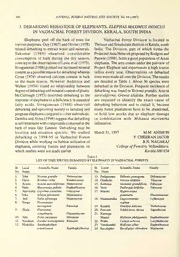
Debarking behaviour of elephants, Elephas maximus indicus in Vazhacal Forest Division, Kerala south India PDF
Preview Debarking behaviour of elephants, Elephas maximus indicus in Vazhacal Forest Division, Kerala south India
, 392 JOURNAL, BOMBAYNATURAL HIST. SOCIETY, Vol. 94 (1997) DEBARKING BEHAVIOUR OF ELEPHANTS, ELEPHAS MAXIMUS INDICUS 3. IN VAZHACHAL FOREST DIVISION, KERALA, SOUTH INDIA Elephants peel off the bark of trees for Vazhachal Forest Division is located in various purposes. Guy (1967) and Olivier (1978) Thrissur and Ernakulam districts ofKerala, south related debarking to extract water and minerals. India. The Division, part of which forms the Sukumar (1989) observed considerable Protected AreaNetworkproposed by Rodgersand consumption of bark during the dry season, Panwar (1988), holds a good population ofAsian contrary to the observations ofLaws etal. (1975). elephants. The area comes under the purview of Sivaganesan (1988)pointed out increased mineral Project Elephant and experiences a high tourist content as apossiblereason fordebarking whereas influx every year. Observations on debarked Croze (1974) observed calcium content in bark trees were made all over the Division. The results as the main reason. However Anderson and are detailed in Table 1. About 36 species were Walker (1974) found no relationship between debarked in the Division. Frequent incidence of degree ofdebarking and mineral content ofplants. debarking was found in Tectona grandis, Acacia McCullough (1973) described debarking as the auriculiforms, Grewia tiliifolia. Further studies response ofelephants to a deficiency in essential are required to identify the exact cause of fatty acids. Sivaganesan (1988) observed debarking behaviour and to curtail it, because debarking and uprooting mainly in lactating and many forest plantations have to be abandoned, pregnantelephants compared to other individuals. or hold low stocks due to elephant damage Damiba and Abies (1994) suggest that debarking in combination with Mikania micrantha is selftreatment with compounds contained in the infestation. bark of trees like Lannea. Debarking may be location and situation specific. We studied March 31, 1997 M.M. ANIMON debarking in 1994-95 in Vazhachal Forest Y. CHEERAN JACOB NAGARAJ Division while working on habitat utilisation of B.N. elephants, covering forests and plantations on College ofForestry, Vellanikkara which studies were not made earlier. Kerala 680 654 Table 1 LIST OFTREE SPECIES DEBARKED BY ELEPHANTS IN VAZHACHAL FORESTS SI. Local Scientific Name Family SI. Local Scientific Name Family No. Name No. Name 1. Teku Tectona grandis Verbenaceae 13. Pattippunna Dilleniapentagyna Dilleniaceae 2. Elavu Bombax ceiba Bombacaceae 14. Chadachi Grewia tiliifolia Tiliaceae 3. Acacia Acacia auriculiformis Mimosaceae 15. Sesbania Sesbania grandiflora Fabaceae 4. Vatta Macaranga peltata Euphorbiaceae 16. Veeti Dalbergia latifolia Fabaceae 5. Anaviratty Laportea crenulata Urticaceae 17. Marotti Hypnocarpus 6. Vaka Albiziafalcataria Mimosaceae pentandra Flacourtiaceae 7. Irul Xylia xylocarpa Mimosaceae 18. Mammaruthu Lagerstroemia Lythraceae 8. Venga Pterocarpus reginae marsupium Fabaceae 19. Kumbil Gmelina arborea Verbenaceae 9. Thalir Flacourtia 20. Poovam Schleichera oleosa Sapindaceae cataphracta Flacourtiaceae 21. Kurangu 10. Athi Ficus racemosa Moraceae Manjal Mallotus philippensis Euphorbiaceae 11. Nasakam Euodia roxburghiana Rutaceae 22. Pezhu Careya arborea Lecythidaceae 12. Madukka Xanthophyllum 23. Vattakumbil Mallotus albus Euphorbiaceae amottianum Xanthophyllaceae 24. Eucalyptus Eucalyptus citriodora Myrtaceae MISCELLANEOUS NOTES 393 Table (contd.) 1 LIST OFTREE SPECIES DEBARKED BY ELEPHANTS IN VAZHACHAL FORESTS SI. Local Scientific Name Family SI. Local Scientific Name Family No. Name No. Name 25. Murukku Erythrina indica Fabaceae 31. Edampiri Helicteres isora Sterculiaceae 26. Malayathi Bauhinia racemosa Caesalpiniaceae 32. Encha Acacia intsia Mimosaceae 27. Venteku Lagerstroemia 33. Maruthu Terminalia paniculata Combretaceae microcarpa Lythraceae 34. Edana Olea dioica Oleaceae 28. Nedunar Polyalthiafragrans Annonaceae 35. Papita Pterocymbium 29. Vetti Aporusa lindleyana Euphorbiaceae tinctorium Sterculiaceae 30. Malayuram Pterospermum 36. Uthi Lannea reticulatum Sterculiaceae coromandelica Anacardiaceae References Anderson, G.D. & B.H. Walker (1974): Vegetation Press. composition and elephant damage in the Sengwa McCullough, K.G. (1973): The African elephants Wildlife Research Area, Rhodesia. Journal of the deficient in essential fatty acids. Nature 242: 267- South African Wildlife Management Association 4: 268. 1-14. Olivier,R.C.D. (1978): OntheecologyofAsian elephant Croze, H. (1974): TheSeronerabull problem 2-Thetrees. with particularreferencetoMalayaand Srilanka,Ph.D. E. Afr. Wildl. J. 12: 29-47. Thesis, University ofCambridge, U.K. 454 pp. Damiba, E.T. & E.D. Ables (1994): Population Rodgers, W.A. & H.S. Panwar (1988): Planning a characteristics and impacts on woody vegetation of Wildlife Protected Area Network in India. Vol. 1&2. elephants on Nazinga game ranch, Burkinofaso. Wildlife Institute of India, Dehra Dun. Pachyderm 46-53. Sivaganesan, N. (1988): EcologyoftheElephant.Annual Guy, P.R. (1967): Diurnal activity pattern of elephant in Report 1988-89. (Ed.) Daniel, J.C. Bombay Natural the Sangwa Area, Rhodesia. E. Afr. Wildl. J. 14: 285- History Society, Mumbai 35 pp. 295. Sukumar, R. (1989): The Asian Elephant-Ecology and Laws, R.M., I.S.C. Parker & R.C.B. Johnstone (1975): Management. Cambridge University Press, U.K. Elephants and Their Habitats. Oxford, Clarendon 244 pp. VAGINAL PROLAPSE IN A WILD CHITAL, AXIS AXIS 4. IN RAJAJI NATIONAL PARK, INDIA. From November 1992 to May 1993, 1 was prolapse or ballooned vagina (Banerjee 1991). studying habitat use by the chital (Axis axis in Retention of placenta or weakening of the ) Dholkhand, Rajaji National Park, India. On peritonial muscles or dystokia may cause this 31st January, 1993 (morning), I saw a group of (Sankar 1990). It makes parturition difficult and 20 chitals, including 3 fawns, foraging on a can cause temporary or even permanent sterility hillock. One doe had vaginal prolapse. The size (Banerjee 1991). ofthe prolapsed mass was about that ofa cricket Sankar (1990) who reported recto-vaginal ball. The doe’s normal belly suggested that it was prolapse in a wild chital in Sariska Tiger Reserve notpregnant. No fawn attended the female during concluded that animals in such condition may the 20 minutes of my observation. have poor chances of survival. 1 have seen The vagina and also the uterus can get two domestic dogs with vaginal prolapse. reversed and protrude out through the vulva Both were emaciated, never regained health during advanced pregnancy or when approaching even after months, before they were put parturition. This condition is called vaginal down.
